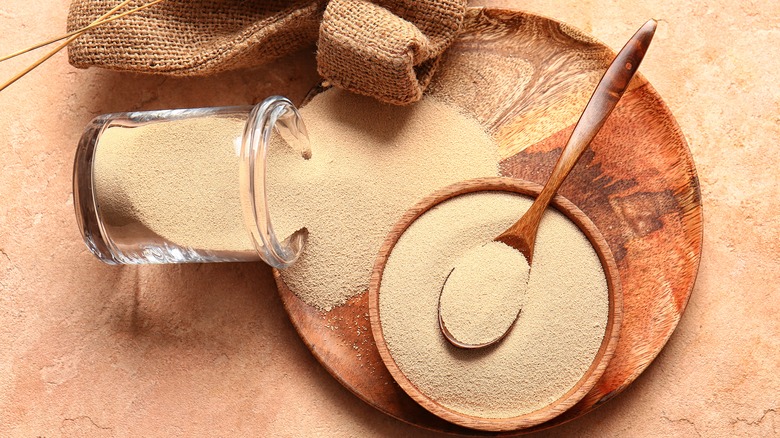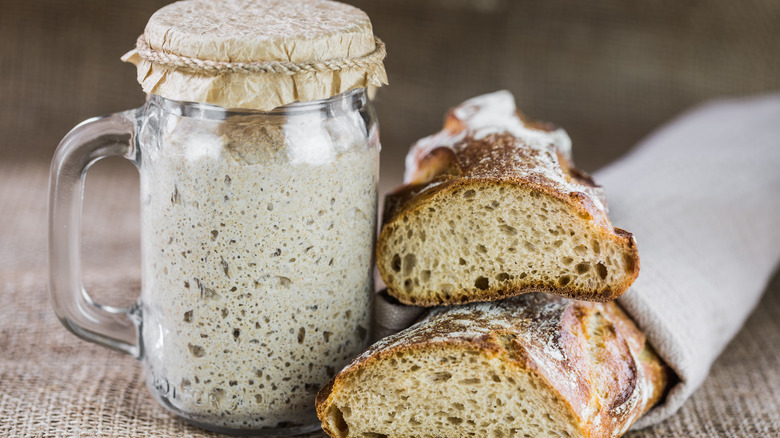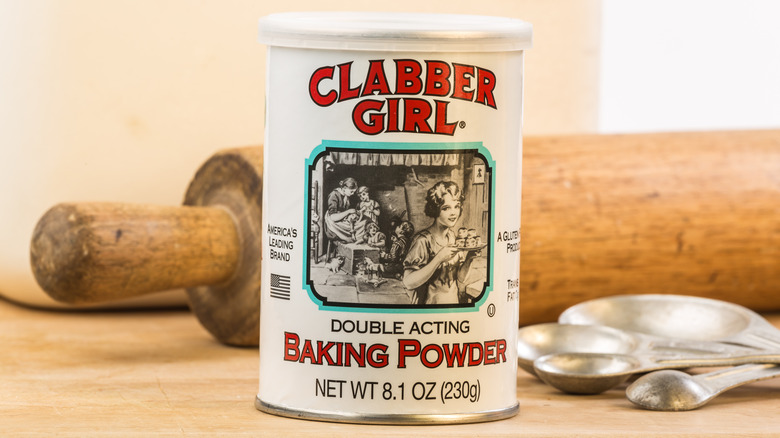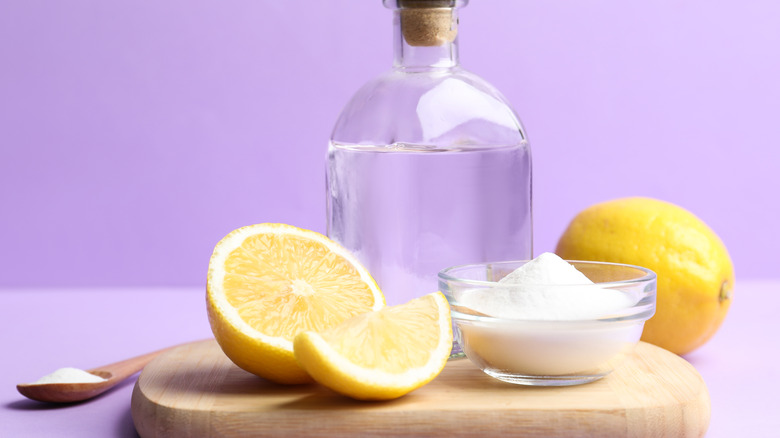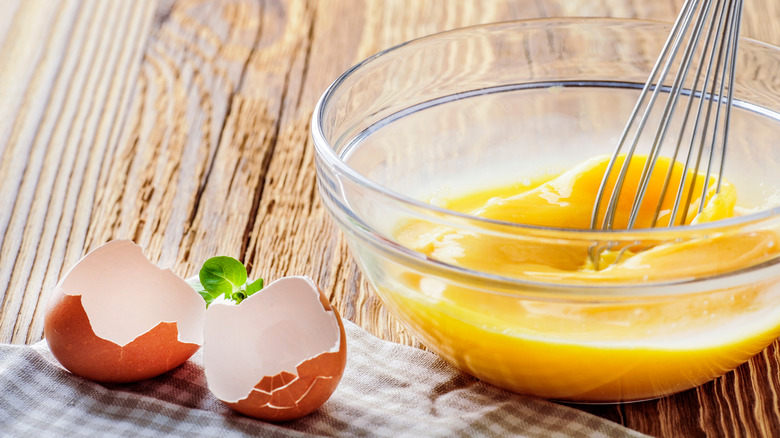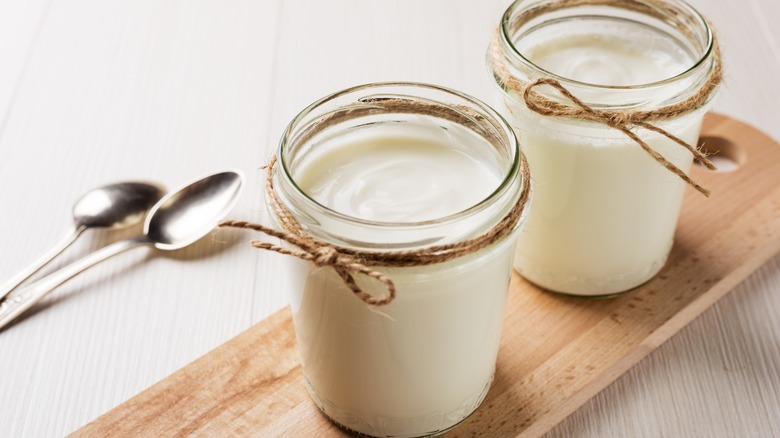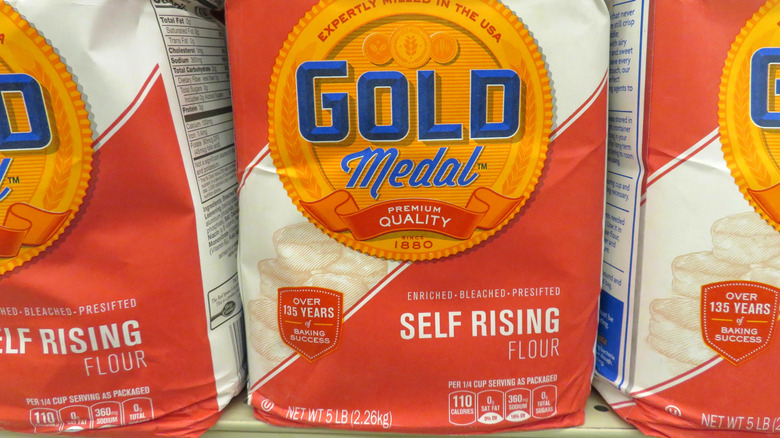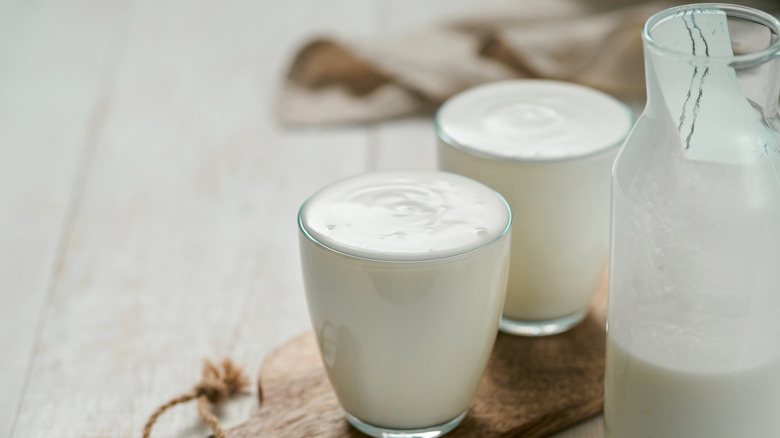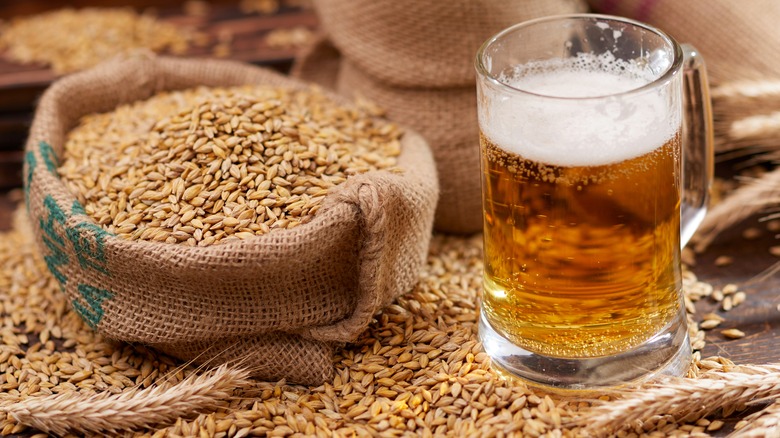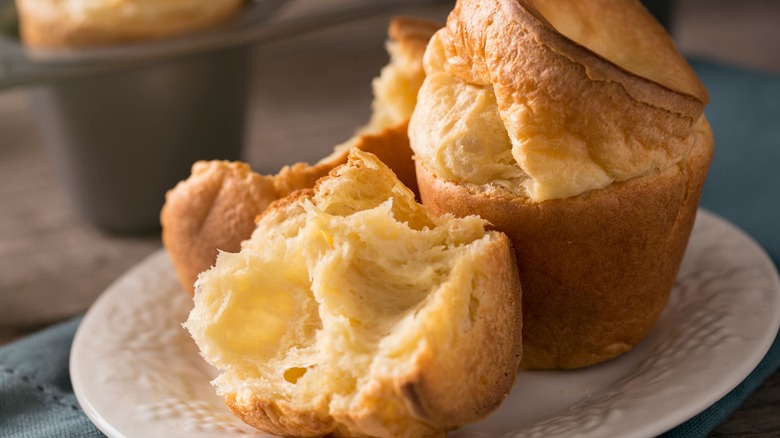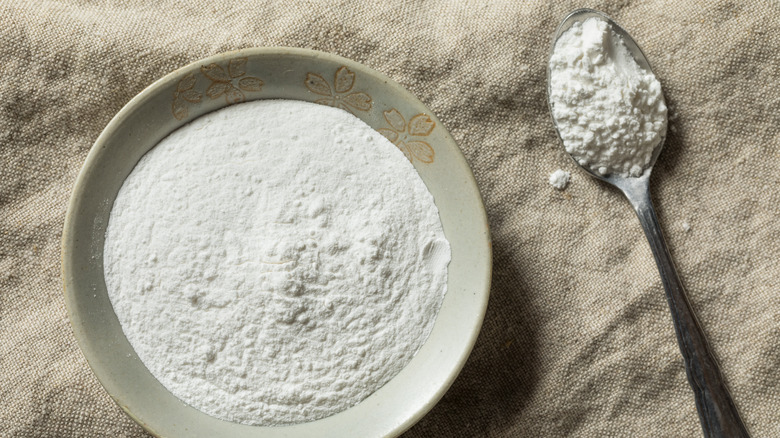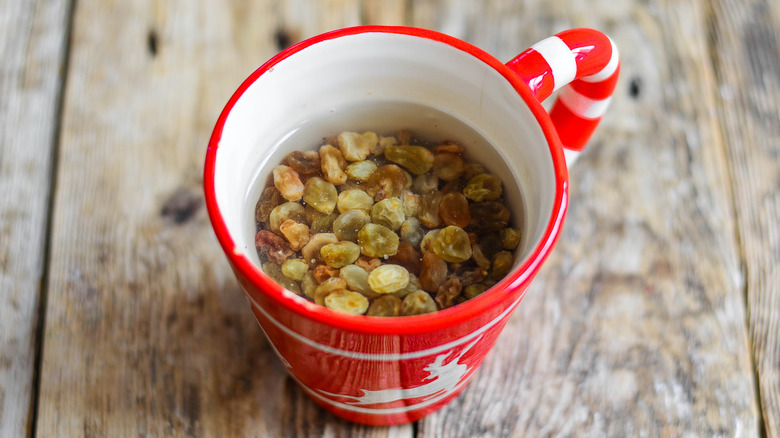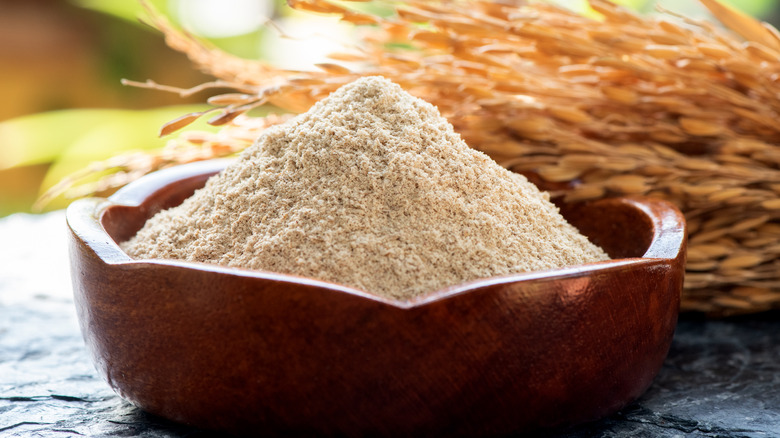13 Best Substitutes For Yeast
Yeast ferments foods and drinks by eating sugar and releasing gas. In baked goods, this carbon dioxide is a leavening agent that lets your treats rise. And humans have been using yeast for a long time — since at least 5,000 years ago in ancient Egypt.
You'll find different varieties when you purchase yeast at the grocery store. So, what's the difference between cake, active dry, and instant yeast? Cake yeast (also known as fresh or wet yeast) is sold in a compressed block form and needs to be refrigerated; it's most often used in baked goods that take longer to rise. Active dry yeast is dehydrated cake yeast and is suitable for bread that proves in one day. Instant dry yeast is ground active dry yeast; it's the only of these three that you can directly add to your baked goods without first hydrating it.
You should know how the yeast functions in your recipe, especially if you need to replace it. Why would you replace yeast? One of the biggest mistakes people make when baking with yeast is using yeast that's no longer fresh. If you find yourself with "bad" yeast and no time to run to the store, you don't find yeast at the store, or if you're allergic to it, we've got you covered. Here are the best substitutes for yeast.
Sourdough starter
Sourdough starter is perhaps the best replacement for yeast because it contains yeast. Sourdough starters feed on and collect wild yeast and bacteria from the air. A study published by the American Society for Microbiology found that because sourdough starters feed on wild fungi, bacteria, and yeast, almost no two starters are alike. That's one of the reasons all loaves of sourdough bread taste so different. That does mean, though, that using a sourdough starter to replace your yeast has the potential to impart some of that characteristic funky flavor to your baked goods.
Also, note that this isn't a quick replacement unless you already have some starter lying around. Scientific American says that it takes about two weeks to make a starter. Of course, considering how popular making sourdough bread became during the COVID-19 pandemic, there's a good enough chance you do have some on hand.
If that's the case, King Arthur Baking Company has some suggestions about how to use sourdough starter in your baking (apart from the obvious). Get ready to do some math. The outlet states that 1 cup of sourdough starter equals about 3 ½ ounces of liquid and flour each, meaning you need to subtract that amount from your recipe.
Here's where things get even more interesting. King Arthur Baking Company suggests replacing yeast with the sourdough starter and adding it to cakes, muffins, and pancakes, saying the starter adds an extra bit of "oomph" to baked goods.
Baking powder
Whereas yeast is a biological leavener, baking powder is a chemical one. "Chemical leavener" refers to the fact that they leaven through a chemical reaction.
Baking powder is made of baking soda and an acid, cream of tartar, or monocalcium phosphate. When they meet heat, they produce gas — carbon dioxide — and leaven your baked goods (via the National Library of Medicine).
There's a subtle yet essential difference between the way yeast and baking powder leaven foods. According to the Science of Cooking, yeast creates gas bubbles through fermentation because it eats sugar. This fermentation process is why you can make alcohol from yeast but not from baking powder. This fermentation is why you should give the yeast time to rise. It also offers yeasted foods their characteristic aroma.
Baking powder won't give you that same flavor, but in a pinch, you can use it in place of yeast in some recipes. Livestrong states that baking powder works as a yeast substitute in pizza dough and batter-based recipes, but not to try it in kneaded-bread recipes. The swap-out ratio is 1 teaspoon of baking powder for every cup of white flour, and 1 ¼ teaspoon for every cup of whole wheat flour.
Baking soda and acid
Baking soda is a chemical leavener and is one of the ingredients of baking powder. If you've ever wondered what the difference between baking soda and baking powder is, that's it. So, for baking soda to work as a leavener, you need to add an acid to it. The easiest acids to do this with are vinegar, lemon juice, or yogurt.
Remember to cook your batter or dough immediately when using baking soda and an acid. Because the leavening process begins as soon as the acid and baking soda make contact, the longer it sits, the less efficacy it'll have. With that in mind, adding your acid towards the end of your ingredient mixing is best.
For every cup of flour you use, use ¼ teaspoon of baking soda. Use 1 tablespoon of an acid, like lemon juice, for every ¼ teaspoon of baking soda you've used (via Foods & Nutrition Encyclopedia). Bear in mind some recipes call for baking soda to begin with, such as this Irish brown soda bread recipe.
Eggs
The leavening power of eggs is twofold: their high water and protein content. The Science of Cooking says egg whites are 88% water, while yolks are about 50%. The liquid in the eggs turns to steam during baking, causing baked goods to rise dramatically. The proteins in eggs also help them leaven baked goods. Beating or whipping eggs (the whites in particular) causes the proteins to unwind and expand, allowing them to cover air bubbles.
If, for some reason, eggs aren't part of your diet, aquafaba — the cooking liquid from beans — can work here instead. It's best to use garbanzo beans or white beans since the aquafaba from darker beans won't look as much as egg whites. Beat and whip your aquafaba as you would egg whites and use them to leaven your baked goods. Aquafaba isn't as stable as egg whites are, so King Arthur Baking Company suggests adding ⅛ teaspoon of cream of tartar for every 2 tablespoons of bean liquid.
Greek yogurt
Because of its high acid content, you can substitute Greek yogurt for yeast. You need to first mix it with baking soda. Use a ½ cup of yogurt and a ¼ teaspoon of baking soda for every teaspoon of yeast your recipe needs. Remember to reduce the other liquid ingredients in your recipe accordingly.
Using yogurt has benefits beyond leavening, though. One of the suggested ways to use leftover yogurt is in baking because of the tangy moistness it imparts to your baked treats. It's also a way to cut back on the fat in a recipe (if that's something you're interested in doing). Yogurt is also high in protein, calcium, and potassium (via the USDA).
Note that this is a chemical leavening reaction, so it's not recommended for kneaded doughs. However, because yogurt itself is fermented, you'll be left with a zippy flavor a bit closer to traditional yeasted treats.
Self-rising flour
If you're out of yeast but have self-rising flour in your pantry, you're in luck. Self-rising flour is pre-mixed with baking powder and salt, so you don't have to worry about adding leavener. Self-rising flour is usually used for biscuits and muffins; anything that needs to be light and fluffy.
According to Bob's Red Mill, 19th-century English sailors invented self-rising flour so that they could bake better while out to sea. The flour received a U.S. patent in 1849.
Substituting with self-rising flour can get tricky and shouldn't be done for kneaded bread. However, if you're craving some yeast biscuits but don't have the little organisms on hand, opt for self-rising flour. This flour is a staple ingredient in Southern United States kitchens specifically for this purpose.
Note that self-rising flour doesn't keep as long as other flours, so it's best to buy it in smaller quantities than your other flours. If you want to make your own, mix 1 ½ teaspoon baking powder and ¼ to ½ teaspoon salt for every cup of flour.
Buttermilk
Basically, buttermilk is what it sounds like: It is the liquid byproduct of cream that has been made into butter. Baking soda and buttermilk combine to make a good substitute for yeast, particularly in gluten-free baking. The National Library of Medicine says that buttermilk is the best liquid for gluten-free baking due to its high-acid content, as well as because buttermilk can inhibit gluten from forming. When acid and baking soda meet, they work as a leavening agent.
If you can't find buttermilk at the store, you can also create buttermilk at home by mixing an acid such as 1 tablespoon of lemon juice or vinegar into 1 cup of any type of milk. You can also use 1 cup of milk and 1 ¾ teaspoon of cream of tartar. Or, kefir is a one-to-one ratio swap, according to King Arthur Baking Company.
Like all liquid yeast substitutes, you need to adjust the amount of liquid in your recipe when you use buttermilk instead of yeast. Healthline suggests using ½ teaspoon buttermilk and ½ teaspoon baking soda for every teaspoon of yeast your recipe requires.
Beer
Beer is made through fermentation and has yeast in it. In fact, both "baker's yeast" and "brewer's yeast" are Saccharomyces cerevisiae. But according to the University of Rochester, Saccharomyces cerevisiae has many strains, and different strains are better suited to different applications, such as baking or alcohol-making. Humans actually domesticated wild yeast to suit our needs and for individual processes. Also, according to the University of Rochester, the way yeast divides determines the flavor of the beer.
What does this all mean for your yeast replacement? For one, know that your baked goods will take on some of the distinct flavors of the beer you use. However, unlike other yeast substitutes, it does have that yeasty flavor.
Interestingly, it is not the yeast in beer that helps it leaven foods, but the carbonation, says King Arthur Baking Company. The company recommends always using fresh beer at room temperature and says that beer is particularly delicious in baked goods. It says you should pay attention to the flavor notes and pair them with your recipe. For example, dark beers are nuttier with nuts of coffee and chocolate and are particularly awesome in desserts. If you're more interested in something savory, try this beer bread recipe, which uses beer and baking powder for an extra rise. You could even try this with kombucha.
Steam
There are four types of leaveners: organic, chemical, mechanical, and physical. Steam is a physical leavener. According to Food A Fact of Life, steam increases the volume of foods as the air or liquid within a food evaporates. These can be liquids, eggs, or solids, like butter. In this way, steam is integral to all forms of leavening, though some foods rely on it more than others (via Britannica). Some baked goods that rely on steam are choux pastry and croissants. Batter-based foods, such as some biscuits, can get a boost by whipping air bubbles into the batter.
Because steam leavening relies so heavily on evaporation, it leaves an air pocket in products after rising. Suppose you want to use steam as a leavening agent. In that case, it's best to switch to a recipe that already relies on the process, such as this fluffy dutch baby recipe or homemade puff pastry.
Cream of tartar
You may be wondering, what is cream of tartar, really? Rest assured, your instincts that it's not related to the tartar sauce you use for fish and chips are correct. No, cream of tartar is a by-product of the wine-making industry and is scientifically known as potassium bitartrate or potassium hydrogen tartrate.
Cream of tartar is a common ingredient in baking powder, alongside baking soda. So, to use cream of tartar as a yeast replacement, you'll need to mix ½ teaspoon of cream of tartar and ½ a teaspoon of baking soda for every teaspoon of yeast your recipe needs. Cream of tartar is a good replacement for batters and quick breads, but not so much for kneaded bread.
Besides leavening, cream of tartar is an excellent stabilizing agent when whipping up eggs or aquafaba. It also keeps sugar crystals from forming, which is why you'll often see it in frosting and icing recipes. And though you won't be consuming much cream of tartar, you should know that just 1 teaspoon contains 11% of your recommended daily potassium intake requirement (via Healthline).
Make your own
While by no means a quick fix, making your own yeast is a fun project and a good idea should another yeast shortage roll around. Here's how to make your own yeast using raisins.
First, you need time and patience since the process takes just over a week. Next, grab 1 ¼ cups of either spring or filtered water. You can't use tap water here because the potential additives could ruin the process.
Then, get a tablespoon of sugar, a ½ cup of raisins, and a jar. Put all your ingredients in the jar. Cover it tightly with a paper coffee filter, and don't touch it for a week. After seven days, you'll notice bubbles and an alcohol-y smell. On the eighth day, the bubbles will be even bigger. At this point, you can strain the water and toss the raisins.
Next, add 1 ¼ teaspoon sugar and 1 cup of flour to your raisin water. Let it rise in a warm place before moving it to the fridge. You can use this starter in place of yeast in any bread recipe that calls for yeast. Note: You'll need to keep feeding this starter to keep it alive.
Rice bran
According to the book Rice Bran and Rice Bran Oil, defatted rice bran is a byproduct of making rice bran oil.
Rice bran can be used in place of yeast if you're brewing or fermenting alcohol. A study published in the Journal of Biobased Materials and Bioenergy found that substituting rice bran or defatted rice bran didn't significantly affect ethanol fermentation's efficacy. The USDA says rice bran is also being looked into as a low-cost alternative growing medium for yeast. Liquid Bread Mag says that you can swap out artificial yeast used in alcohol fermentation with rice bran.
Home alcohol brewing comes with risks, so be careful before embarking on this project. According to Learning to Homebrew, you must keep everything sanitary so only the microorganisms you want to be growing are. The outlet suggests smelling your homebrew to test it — if it smells off or too chemically, don't drink it. And while you generally can't produce enough methanol in your homebrewing for it to be dangerous, you can burn a small amount of it to test it. If your beverage burns yellow instead of blue, it has way too much methanol.
